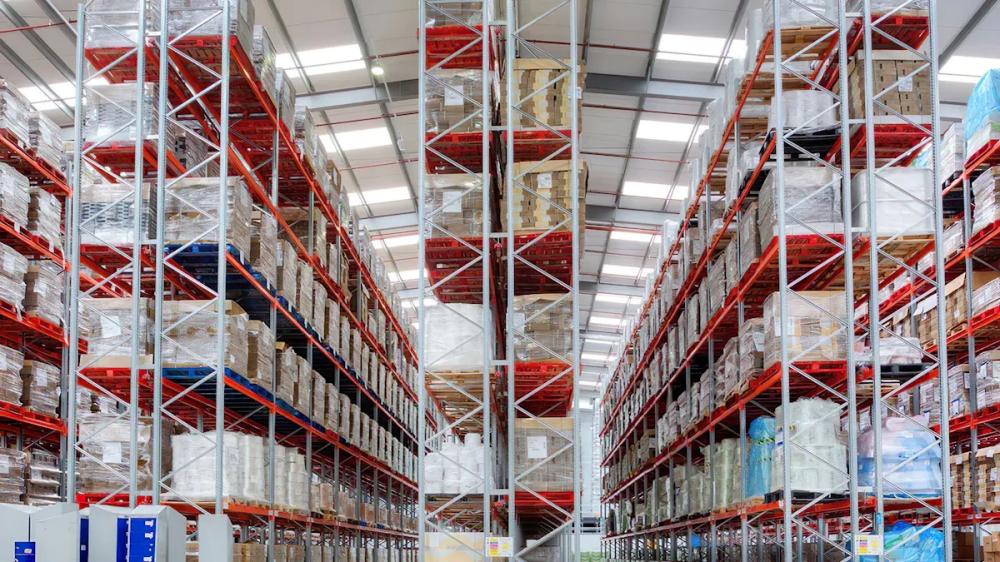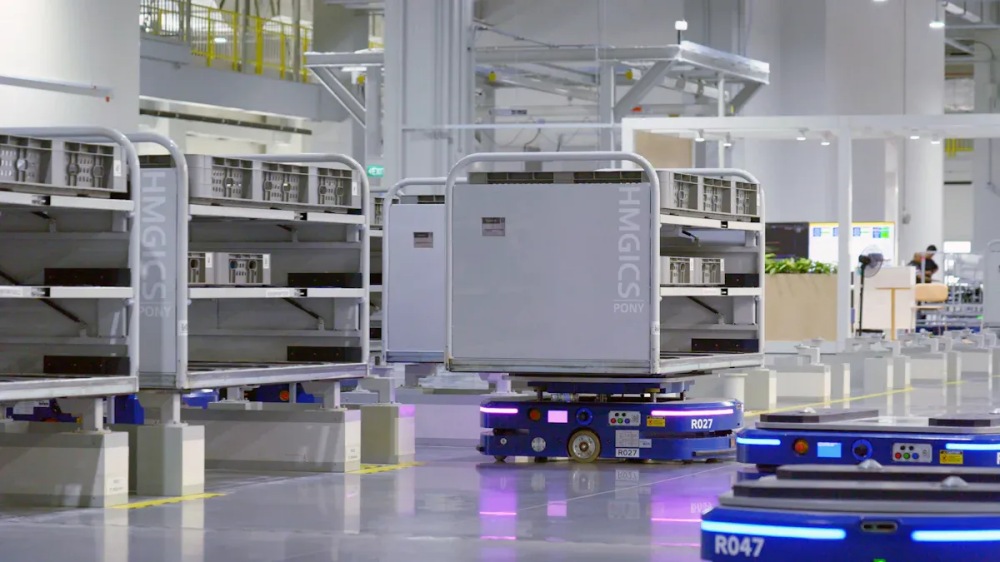ระบบชั้นวางสินค้าอัจฉริยะเปลี่ยนวิธีการทำงานของคลังสินค้า ช่วยเพิ่มพื้นที่และเพิ่มประสิทธิภาพการดำเนินงาน คลังสินค้าทั่วไปหลายแห่งใช้พื้นที่เพียงประมาณหนึ่งในสี่ของพื้นที่ทั้งหมด ซึ่งหมายความว่าพื้นที่ส่วนใหญ่ไม่ได้ถูกใช้งาน
-
พื้นที่มากถึง 78% มักจะว่างเปล่าก่อนที่จะใช้ระบบชั้นวาง
การวางซ้อนแนวตั้ง ชั้นวางแบบยืดหยุ่น และการติดตามแบบดิจิทัลช่วยแก้ปัญหาการจัดเก็บ โซลูชันอัจฉริยะช่วยให้บริษัทต่างๆ จัดเรียงสินค้า ค้นหาสินค้าได้อย่างรวดเร็ว และปรับเปลี่ยนได้ตามต้องการ
เพิ่มพื้นที่เก็บข้อมูลสูงสุด

การประเมินสินค้าคงคลัง
เพื่อให้ได้พื้นที่จัดเก็บเพิ่มขึ้น คลังสินค้าควรตรวจสอบสินค้าที่มีอยู่ก่อน วิธีนี้จะช่วยให้ทราบว่าสินค้าชิ้นไหนใช้พื้นที่มากที่สุดและชิ้นไหนขายได้ไม่เร็ว ผู้จัดการมักจะตรวจสอบรายการสินค้าบ่อยครั้งเพื่อนำสินค้าส่วนเกินออก นอกจากนี้ พวกเขายังย้ายสินค้าไปมาโดยใช้ข้อมูลล่าสุด ซึ่งช่วยให้คลังสินค้าสามารถปรับเปลี่ยนได้อย่างรวดเร็วเมื่อลูกค้าต้องการสินค้าที่แตกต่างออกไป
-
ทีมคลังสินค้าจะนับสินค้าบ่อยๆ เพื่อค้นหาข้อผิดพลาดและดูว่าพนักงานจำเป็นต้องได้รับการฝึกอบรมเพิ่มเติมหรือไม่
-
กฎเกณฑ์และการตรวจสอบที่ดีขึ้นสามารถหยุดการสูญเสียสินค้าคงคลังได้
-
การจัด SKU จะค้นหาสินค้าที่ขายไม่ดีและลบออก
-
ระบบไดนามิกจะเคลื่อนย้ายสินค้าตามความเร็วในการขาย
การจัดเรียงสินค้าคงคลังอย่างถูกวิธีช่วยให้ทุกคนเห็นสินค้าในคลังสินค้าได้อย่างชัดเจน อีกทั้งยังช่วยลดการใช้พื้นที่โดยเปล่าประโยชน์ เมื่อจัดเรียงสินค้าตามประเภทหรือปริมาณที่ต้องการ คลังสินค้าจะไม่มีพื้นที่ว่างอีกต่อไป นอกจากนี้ยังช่วยให้บันทึกสินค้าคงคลังถูกต้องแม่นยำ ด้วยเหตุนี้ คลังสินค้าจึงใช้พื้นที่ได้อย่างมีประสิทธิภาพและประหยัดค่าใช้จ่าย
เคล็ดลับ: นำสิ่งของที่เหมือนกันมารวมกันและนับบ่อยๆ วิธีนี้จะช่วยให้บันทึกสินค้าคงคลังถูกต้องและไม่เปลืองพื้นที่
การวางผังเค้าโครง
การจัดวางที่ดีจะช่วยให้ใช้พื้นที่จัดเก็บได้อย่างมีประสิทธิภาพมากขึ้น การวางแผนเริ่มต้นจากการพิจารณาผังพื้นและขนาดของอาคาร ผู้จัดการต้องคำนึงถึงความสูงของเพดานและน้ำหนักที่พื้นสามารถรับได้ นอกจากนี้ยังต้องพิจารณาถึงตำแหน่งของเสาด้วย
-
วิธีการทำงานของคลังสินค้า เช่น การจัดเก็บสิ่งของเป็นเวลานานหรือการจัดส่งคำสั่งซื้อ จะทำให้รูปแบบเปลี่ยนไป
-
การปฏิบัติตามกฎความปลอดภัย เช่น การรักษาทางออกให้โล่งและทางเดินให้กว้างขวาง ถือเป็นสิ่งสำคัญมาก
-
การใช้เทคโนโลยี เช่น ระบบการจัดการคลังสินค้า สามารถทำให้การจัดวางทำงานได้ดีขึ้น
-
ลองดูผังพื้นแล้วดูว่ามีพื้นที่เท่าใด
-
จัดทำช่องทางเพื่อให้ผู้คนสามารถเคลื่อนตัวได้สะดวกและหยิบสินค้าได้เร็ว
-
ลองคิดดูว่ามีผลิตภัณฑ์จำนวนเท่าใดและมีประเภทใดบ้างเพื่อเลือกเค้าโครงที่ดีที่สุด
การวางผังที่ดีช่วยให้คุณใช้ชั้นวางสูงและชั้นวางแบบเคลื่อนย้ายได้ ตัวอย่างเช่น ร้านค้าแห่งหนึ่งใช้ชั้นวางแนวตั้งและชั้นวางพาเลท ทำให้มีพื้นที่เพิ่มขึ้น 30% บริษัทขนส่งแห่งหนึ่งทำให้การหยิบสินค้าเร็วขึ้นด้วยการใช้ชั้นวางสูง ทำให้พนักงานหยิบสินค้าได้ง่าย
หมายเหตุ: การจัดวางอย่างชาญฉลาดไม่เพียงแต่ช่วยประหยัดพื้นที่ แต่ยังช่วยให้คนงานปลอดภัยและทำงานได้เร็วขึ้นอีกด้วย
การซ้อนแนวตั้ง
การวางซ้อนแนวตั้งหมายถึงการใช้พื้นที่ด้านบนเพื่อจัดเก็บสิ่งของได้มากขึ้น การวางชั้นให้สูงขึ้นจะช่วยให้คลังสินค้าสามารถจัดเก็บสิ่งของได้มากขึ้นโดยไม่ทำให้พื้นที่มีขนาดใหญ่ขึ้น กลยุทธ์นี้เมื่อใช้ร่วมกับ
ชั้นวางอุตสาหกรรมความจุสูง
ช่วยให้บริษัทต่างๆ สามารถเพิ่มพื้นที่จัดเก็บข้อมูลให้สูงสุดในพื้นที่เดียวกันได้
-
การวางซ้อนแนวตั้งช่วยใช้พื้นที่เหนือพื้นได้ดีกว่า
-
ช่วยให้คุณจัดเก็บได้มากขึ้นโดยไม่จำเป็นต้องใช้พื้นที่เพิ่ม
-
พื้นที่เหนือศีรษะของคุณถูกใช้เพื่อให้คุณสามารถวางของได้มากขึ้น
ความปลอดภัยเป็นสิ่งสำคัญอย่างยิ่งเมื่อต้องวางสิ่งของซ้อนกันสูง ชั้นวางสินค้าต้องได้รับการโหลดและขนถ่ายอย่างถูกวิธีเพื่อไม่ให้สินค้าตกหล่น การตรวจสอบชั้นวางสินค้าบ่อยครั้งจะช่วยให้พบปัญหาได้ คนงานจำเป็นต้องเรียนรู้วิธีการวางชั้นวางสินค้าอย่างปลอดภัยและรู้ว่าน้ำหนักเท่าใดจึงจะปลอดภัย ทางเดินต้องโล่งและทางออกต้องไม่กีดขวาง
โซลูชันระบบชั้นวางอัจฉริยะ
ระบบชั้นวางพาเลท
ระบบชั้นวางพาเลทช่วยให้คลังสินค้าสามารถจัดเก็บสิ่งของได้มากขึ้นในพื้นที่ที่น้อยลง ระบบนี้ใช้
ชั้นวางพาเลทสำหรับงานหนัก
เพื่อยึดพาเลทอย่างปลอดภัยและมีประสิทธิภาพ
|
ประเภทของระบบชั้นวาง
|
ลักษณะเฉพาะ
|
แอปพลิเคชัน
|
|
ชั้นวางแบบเลือกได้
|
เข้าถึงง่าย เหมาะสำหรับสต๊อกสินค้าแบบ FIFO
|
ค้าปลีก, เภสัชกรรม
|
|
ชั้นวางแบบสองชั้นลึก
|
จัดเก็บได้มากขึ้น แต่ต้องการพื้นที่ทางเดินน้อยลง
|
การจัดเก็บสินค้าในคลังสินค้า
|
|
ชั้นวางไดรฟ์อิน
|
สามารถจุสิ่งของได้มากมาย
|
การจัดเก็บความหนาแน่นสูง
|
|
ชั้นวางแบบดันกลับ
|
ทำให้ได้รับไอเทมเร็วขึ้น
|
คลังสินค้าทั่วไป
|
|
ชั้นวางสินค้าแบบไฮเบย์
|
ชั้นวางสูง ใช้เครนพิเศษ
|
การเพิ่มพื้นที่ให้สูงสุด
|
ชั้นวางแบบ Push-back ใช้ชั้นวางสูงเพื่อประหยัดพื้นที่ ช่วยให้คุณวางพาเลทซ้อนกันได้ลึกขึ้น ชั้นวางแบบ Selective ช่วยให้เข้าถึงพาเลทแต่ละอันได้โดยตรง เหมาะสำหรับสถานที่ที่มีสินค้าจำนวนมาก ชั้นวางแบบ Double-Deep ช่วยให้ใช้พื้นที่ได้อย่างคุ้มค่า เหมาะอย่างยิ่งสำหรับการจัดเก็บสินค้าแบบเข้าก่อนออกก่อน ชั้นวางแบบ Drive-in สามารถจัดเก็บสินค้าเดิมได้จำนวนมากและจัดเก็บอย่างแน่นหนา
-
ชั้นวางแบบดันกลับจะซ้อนพาเลทให้ลึกเพื่อประหยัดพื้นที่
-
ชั้นวางแบบเลือกสรรเหมาะสำหรับสินค้าที่เคลื่อนไหวเร็วและช้า
-
ชั้นวางแบบสองชั้นเหมาะสำหรับวิธีการจัดทำสินค้าคงคลังบางประเภท
-
ชั้นวางแบบไดรฟ์อินเหมาะที่สุดสำหรับการจัดเก็บสิ่งของจำนวนมากเหมือนกัน
เคล็ดลับ: เลือกระบบจัดเก็บของตามสิ่งของที่คุณจัดเก็บและความถี่ในการหยิบของ
ชั้นวางสินค้าเคลื่อนที่
ชั้นวางสินค้าแบบเคลื่อนย้ายได้สามารถเคลื่อนย้ายบนรางเพื่อเปิดหรือปิดทางเดินได้ ระบบนี้ช่วยประหยัดพื้นที่โดยไม่ต้องมีทางเดินคงที่ คลังสินค้าสามารถจัดเก็บสินค้าในปริมาณเท่าเดิมได้ในพื้นที่ที่น้อยลง
-
ชั้นวางของเคลื่อนที่ช่วยประหยัดพื้นที่ได้ครึ่งหนึ่ง
-
มันจัดเก็บสิ่งของไว้ในพื้นที่ที่เล็กลง
-
ชั้นวางเคลื่อนที่แบบความหนาแน่นสูงใช้ชั้นวางสูง
-
ระบบเหล่านี้รองรับน้ำหนักได้มากตั้งแต่ 3,000 ถึง 30,000 ปอนด์
-
ตัวเลือกที่กำหนดเองช่วยให้คุณเลือกขนาด สี และการตกแต่งได้
-
คุณสมบัติด้านความปลอดภัย เช่น Safety Sweep และ Photo Sweep® ช่วยปกป้องผู้คนและสินค้า
ชั้นวางเคลื่อนที่ในทางเดินช่วยประหยัดพื้นที่ได้อย่างคุ้มค่า อีกทั้งยังช่วยให้สิ่งของต่างๆ ปลอดภัยและค้นหาได้ง่าย
หมายเหตุ: ชั้นวางของในทางเดินแบบเคลื่อนย้ายได้จะเปลี่ยนพื้นที่ทางเดินว่างให้กลายเป็นพื้นที่จัดเก็บของที่มีประโยชน์
ชั้นวางแบบยืดหยุ่น
ระบบชั้นวางแบบยืดหยุ่นช่วยให้คลังสินค้าสามารถปรับเปลี่ยนได้ตามต้องการ ชั้นวางเหล่านี้มีความแข็งแรงและสามารถเคลื่อนย้ายได้ พนักงานสามารถปรับชั้นวางให้เหมาะสมกับขนาดหรือรูปร่างของผลิตภัณฑ์ที่แตกต่างกัน ช่วยให้ใช้พื้นที่ได้อย่างมีประสิทธิภาพและเป็นระเบียบ ปัจจุบันคลังสินค้าหลายแห่งใช้
ชั้นวางจัดเก็บสินค้าแบบโมดูลาร์
เพื่อปรับตัวให้เข้ากับการเปลี่ยนแปลงของสินค้าคงคลังได้อย่างรวดเร็ว ชั้นวางสินค้าสำหรับสินค้าที่มีขนาดหรือรูปทรงแตกต่างกัน ช่วยให้ใช้พื้นที่ได้อย่างคุ้มค่าและเป็นระเบียบ
ชั้นวางแบบยืดหยุ่นช่วยเปลี่ยนพื้นที่เล็กๆ หรือพื้นที่แปลกๆ ให้กลายเป็นพื้นที่จัดเก็บ ชั้นวางความหนาแน่นสูงสามารถจัดเก็บสิ่งของได้มากขึ้นในพื้นที่ที่จำกัด ชั้นวางแบบปรับได้รองรับสินค้าได้หลากหลายขนาด ชั้นวางแบบโมดูลาร์สามารถปรับเปลี่ยนได้อย่างรวดเร็ว คลังสินค้าสามารถตอบสนองความต้องการได้อย่างรวดเร็วเมื่อมีการเปลี่ยนแปลงสินค้าคงคลัง
-
ชั้นวางปรับได้หลายขนาด
-
ระบบโมดูลาร์เปลี่ยนแปลงเพื่อตอบสนองความต้องการใหม่ๆ
-
ชั้นวางแบบยืดหยุ่นช่วยให้จัดเก็บของพิเศษได้ตามต้องการ
-
คลังสินค้าสามารถเปลี่ยนแปลงได้อย่างรวดเร็วโดยไม่ต้องมีการเปลี่ยนแปลงครั้งใหญ่
คำอธิบาย: ชั้นวางแบบยืดหยุ่นช่วยให้คลังสินค้าเป็นระเบียบเมื่อสินค้าคงคลังมีการเปลี่ยนแปลง
ระบบจัดเก็บข้อมูลอัจฉริยะ
ระบบจัดเก็บอัจฉริยะใช้เทคโนโลยีเพื่อติดตามสินค้าคงคลัง ระบบเหล่านี้ประกอบด้วยเซ็นเซอร์ เครือข่ายไร้สาย และซอฟต์แวร์ ช่วยให้พนักงานค้นหาและเคลื่อนย้ายสินค้าได้อย่างรวดเร็ว ระบบจัดเก็บอัจฉริยะช่วยลดข้อผิดพลาดและบันทึกข้อมูลได้อย่างถูกต้อง
|
เทคโนโลยี
|
คำอธิบาย
|
|
ไอโอที
|
เซ็นเซอร์แสดงให้เห็นว่าสิ่งของอยู่ที่ไหนและเคลื่อนที่อย่างไร
|
|
5จี
|
ความเร็วที่รวดเร็วช่วยให้ตัดสินใจได้รวดเร็ว
|
|
อาร์เอฟไอดี
|
คลื่นวิทยุติดตามสินค้าคงคลังโดยอัตโนมัติ
|
|
ระบบบาร์โค้ด
|
รหัสที่พิมพ์ช่วยติดตามรายการและป้อนข้อมูลได้อย่างรวดเร็ว
|
|
ปัญญาประดิษฐ์
|
ดูข้อมูลเพื่อคาดเดาว่าจะต้องทำอะไรต่อไป
|
ระบบจัดเก็บอัจฉริยะช่วยให้พนักงานทำงานได้มากขึ้นและเกิดข้อผิดพลาดน้อยลง ระบบ Pick-to-light ช่วยให้พนักงานค้นหาสินค้าได้อย่างรวดเร็ว ระบบจัดเก็บสินค้าแบบ Flow Racking ช่วยเคลื่อนย้ายสินค้าได้อย่างรวดเร็ว ระบบการจัดการคลังสินค้าช่วยให้การทำงานราบรื่นและบันทึกข้อมูลถูกต้อง เทคโนโลยี RFID ช่วยติดตามสินค้าและป้องกันปัญหาสินค้าหมดสต็อก
|
เทคโนโลยี/กลยุทธ์
|
ผลกระทบต่อผลผลิต
|
ผลกระทบต่อการลดข้อผิดพลาด
|
|
ระบบ Pick-to-light
|
ทำให้ค้นหาสิ่งของได้รวดเร็วยิ่งขึ้น
|
ช่วยให้คนงานทำผิดพลาดน้อยลง
|
|
ระบบชั้นวางแบบไหล
|
เคลื่อนย้ายสินค้าได้รวดเร็ว
|
ทำให้การทำงานมีประสิทธิภาพมากขึ้น
|
|
ระบบการจัดการคลังสินค้า
|
ช่วยให้การทำงานราบรื่นและบันทึกข้อมูลได้อย่างถูกต้อง
|
ลดข้อผิดพลาดในสต๊อกสินค้า
|
|
เทคโนโลยี RFID
|
ติดตามรายการได้ดีขึ้น
|
หยุดข้อผิดพลาดและปัญหาสินค้าหมดสต๊อก
|
เคล็ดลับ: ระบบจัดเก็บอัจฉริยะช่วยให้คลังสินค้าติดตามสินค้าและทำให้ทำงานได้ปลอดภัยและรวดเร็วยิ่งขึ้น
เพิ่มประสิทธิภาพคลังสินค้าให้สูงสุด
การติดตามแบบดิจิทัล
เครื่องมือติดตามดิจิทัลช่วยให้พนักงานเห็นสินค้าคงคลังได้ทันที เครื่องมือเหล่านี้ใช้การสแกนบาร์โค้ด การติดแท็ก RFID และการแจ้งเตือน ซอฟต์แวร์ติดตามสินค้าคงคลังจะแสดงตำแหน่งและจำนวนสินค้า การติดตามแบบเรียลไทม์ช่วยให้พนักงานค้นหาสินค้าได้อย่างรวดเร็วและลดความผิดพลาด หุ่นยนต์สามารถสแกนสินค้าได้ ทำให้พนักงานไม่ต้องตรวจสอบด้วยมือ ซึ่งหมายความว่ามีข้อผิดพลาดน้อยลง คลังสินค้าที่มีระบบติดตามดิจิทัลแทบจะไม่มีข้อผิดพลาดเลย และข้อผิดพลาดลดลงมาก ช่วยให้คำสั่งซื้อออกเร็วขึ้นและทำให้ลูกค้าพึงพอใจ
-
การติดตามแบบเรียลไทม์จะบอกคุณว่าแต่ละรายการอยู่ที่ไหน
-
ระบบบาร์โค้ดและ RFID ช่วยหยุดข้อผิดพลาดในการหยิบสินค้า
-
การแจ้งเตือนช่วยหยุดการหมดสต๊อก
การติดตามแบบดิจิทัลมีความสำคัญต่อประสิทธิภาพของคลังสินค้าและการรักษาบันทึกที่ถูกต้อง
ระบบการติดฉลาก
ระบบการติดฉลากที่ดีจะช่วยให้พนักงานค้นหาสินค้าได้อย่างรวดเร็ว ฉลากที่ชัดเจนจะแสดงให้เห็นว่าสินค้าคืออะไรและควรวางไว้ตรงไหน ทำให้การหยิบสินค้ารวดเร็วขึ้นและป้องกันความผิดพลาด คลังสินค้าควรพิจารณารูปแบบการจัดวางและเลือกวัสดุติดฉลากที่แข็งแรง พวกเขาจำเป็นต้องวางแผนการติดฉลากให้เหมือนกันทุกจุด ฉลากควรทำงานร่วมกับระบบการจัดการคลังสินค้าเพื่อการอัปเดตที่รวดเร็ว พนักงานต้องเรียนรู้วิธีใช้ระบบใหม่
-
ดูผังคลังสินค้า
-
เลือกฉลากที่เหมาะกับพื้นที่ของคุณ
-
วางแผนการติดฉลากให้เหมือนเดิมเสมอ
-
สอนพนักงานและทดสอบระบบก่อนใช้งานทุกที่
ป้ายกำกับที่เหมือนกันเสมอช่วยให้พนักงานค้นหาสิ่งต่างๆ ได้เร็วขึ้น ทำให้การทำงานดีขึ้นและจัดระเบียบสิ่งต่างๆ ได้ดียิ่งขึ้น
ระบบอัตโนมัติ
ระบบอัตโนมัติใช้เครื่องจักรและระบบอัจฉริยะในการทำงาน ตัวอย่างเช่น ระบบจัดเก็บและเรียกคืนสินค้าอัตโนมัติ ระบบสายพานลำเลียง และหุ่นยนต์ เครื่องมือเหล่านี้ช่วยเคลื่อนย้ายและคัดแยกสินค้าและช่วยเหลือคนงาน ระบบอัตโนมัติช่วยประหยัดค่าใช้จ่ายให้กับคนงานและช่วยให้คุณทำงานได้มากขึ้น ตัวอย่างเช่น ระบบ ASRS ใช้ชั้นวางสูงและใช้แรงงานคนน้อยลง หุ่นยนต์ช่วยเคลื่อนย้ายสินค้าโดยไม่ต้องกำหนดเส้นทางเดิน ทำให้คลังสินค้าสามารถเปลี่ยนแปลงได้ง่าย
การเพิ่มประสิทธิภาพอย่างต่อเนื่อง
คลังสินค้าจำเป็นต้องพัฒนาระบบให้ดียิ่งขึ้น ควรเลือกพื้นที่จัดเก็บที่เหมาะสมกับสินค้า และใช้กล่องที่เหมาะสมกับสินค้า เทคโนโลยีอย่างระบบการจัดการคลังสินค้าช่วยให้อัปเดตข้อมูลได้อย่างรวดเร็วเพื่อตัวเลือกที่ดีกว่า การตรวจสอบพื้นที่ทุกๆ สองสามเดือนจะช่วยให้หาพื้นที่ว่างได้ง่ายขึ้นและช่วยให้สินค้าใช้งานได้ดีอยู่เสมอ
-
เลือกพื้นที่จัดเก็บให้เหมาะกับสิ่งของของคุณ
-
ใช้กล่องที่พอดีกับสิ่งของของคุณ
-
ตรวจสอบพื้นที่ของคุณบ่อยๆ เพื่อผลลัพธ์ที่ดีที่สุด
การปรับปรุงอย่างต่อเนื่องช่วยให้มั่นใจได้ว่าการจัดการคลังสินค้าจะทำงานได้ดีแม้จะมีการเปลี่ยนแปลงเกิดขึ้น
ระบบชั้นวางอัจฉริยะช่วยให้คลังสินค้าใช้พื้นที่ได้อย่างมีประสิทธิภาพมากขึ้น และยังช่วยให้ทำงานได้เร็วขึ้น การวางซ้อนแนวตั้ง ชั้นวางที่ยืดหยุ่น และการติดตามแบบดิจิทัลช่วยจัดระเบียบสิ่งของต่างๆ การศึกษาแสดงให้เห็นว่าการจัดเก็บแบบความหนาแน่นสูงและชั้นวางแบบไหลลื่นช่วยให้พนักงานทำงานได้มากขึ้น ชั้นวางที่ออกแบบเฉพาะช่วยให้การจัดเก็บเป็นระเบียบเรียบร้อยและใช้งานง่าย
คลังสินค้าใช้การวางซ้อนแนวตั้งเพื่อให้วางสินค้าได้มากขึ้น ชั้นวางสินค้าที่ยืดหยุ่นสามารถปรับเปลี่ยนได้เมื่อสินค้าคงคลังมีการเปลี่ยนแปลง การติดตามแบบดิจิทัลด้วย WMS และ IoT จะแสดงตำแหน่งสินค้า ณ ขณะนี้ ช่วยให้พนักงานทำงานได้เร็วขึ้น ขั้นตอนเหล่านี้ช่วยให้คลังสินค้าเป็นระเบียบเรียบร้อยและทำงานได้ดี
 ไทย
ไทย  English
English —Ä—É—Å—Å–∫–∏–π
русский ไทย
ไทย Tiếng việt
Tiếng việt 中文
中文




 รองรับเครือข่าย
รองรับเครือข่าย